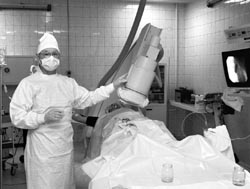Unique heart surgery at Amosov Institute

January 28 was just another working day at the Institute of Cardiology and Cardiovascular Surgery in Kyiv (the Amosov Institute in Ukraine — its popular and deserved name). Another surgery was underway, but a very unusual one, since the patient was under local, not general anesthesia. Instead of the scheduled 6-8 hours, the operation, with the attendant preparatory procedures, lasted about an hour. There was no opening the thorax, the heart was not stopped, and the heart-lung machine was not activated. In fact, what took place was hard to describe as surgery. The patient was being administered an IV, and the doctors around him seemed to be studying the monitor screens to diagnose the disease.
It was Ukraine’s first surgery, but one of 30,000 such operations performed by physicians in 47 countries since 1995, to repair an atrial septal defect (commonly known as the congenital heart disease). Kurt Amplatz of the American Medical Association and the leading Slovak juvenile cardiologist Josef Marsura had combined their efforts to develop what became known as the transcatheter method. The gist of it is “patching up” the opening in the partition between the two upper chambers (atria) of the heart with a jeweler’s precision. If not repaired, this opening causes in patients shortness of breath, increases susceptibility to respiratory diseases, and the risk of early death. The “patch” consists of two linked nickel-titanium alloy wire disks. This alloy does not react to blood, and therefore it is not rejected by the organism. The fiber inside the disks is a well-adaptable kind that has long been used in heart surgery. This patch is designed to fit a special catheter. After it gets through the catheter, the patch positions itself in place. The innovating aspect is that the patch is delivered to the heart by the organism itself, through bloodstream after being administered intravenously. The patient watches everything on the monitor screen, and the only thing he feels is the catheter inserted in his femoral vein. Using X-ray and ultrasound equipment, the doctors monitor the exact placement of the patch. When the “key” fits the “lock,” the catheter is detached and withdrawn from the vein. The procedure is absolutely painless.
Dr. Yuri Panychkyn (who returned from an internship at a juvenile Cardiology Clinic in Bratislava) says that the patient can go home after two days. After that he returns to the clinic only for routine checkups. The patch grows into the cardiac tissue completely in 3-6 months, and the heart regards it as its own. A woman present at the demonstration surgery (she had undergone such an operation in France) said she resumed playing sports after surgery, and no longer felt her usual fatigue and shortness of breath. Dr. Pavel Havora from a Slovak clinic believes that all patients can expect feeling good after this surgery. The eight years of experience and the number of countries adopting this new technique (including such post-Soviet countries as Belarus, Kyrgyzstan, Russia, and Estonia) are evidence that this is not some substandard medicine, but a step into the future. The best evidence though is the fact that the postoperative mortality rate is less than one percent.
Ukrainian cardiologists, however, are concerned about the cost of the bloodless method. Only six Ukrainian patients will get this surgery for free in the course of demonstration period. The rest will have to pay anywhere between $3.5-4 thousand for convenience and aesthetics (no scars on the chest!). The Slovak experts say that the price is not likely to be lowered, even considering the living standard in Ukraine. In Germany, for example, this kind of surgery costs about 13,000 euro, in Slovakia — about $4,000. Valery Suzdaltsev, consultant with the pertinent parliamentary committee, believes that the Parliament would consider financing this project, if there was enough interest among Ukrainian cardiologists, and doctors in the regions agreed to come to Kyiv and learn this new method of heart surgeries.
There are no more objections to adopting this bloodless method in Ukraine. Everybody agrees that it is a wonderful alternative for people with congenital heart disease. Unlike Slovaks who have medical insurance, Ukrainian patients would have to rely on their own resources or someone’s help when choosing between conventional surgery, which means years of recuperation and scar tissue, and an hour of painless procedure that results in restoration of health.






